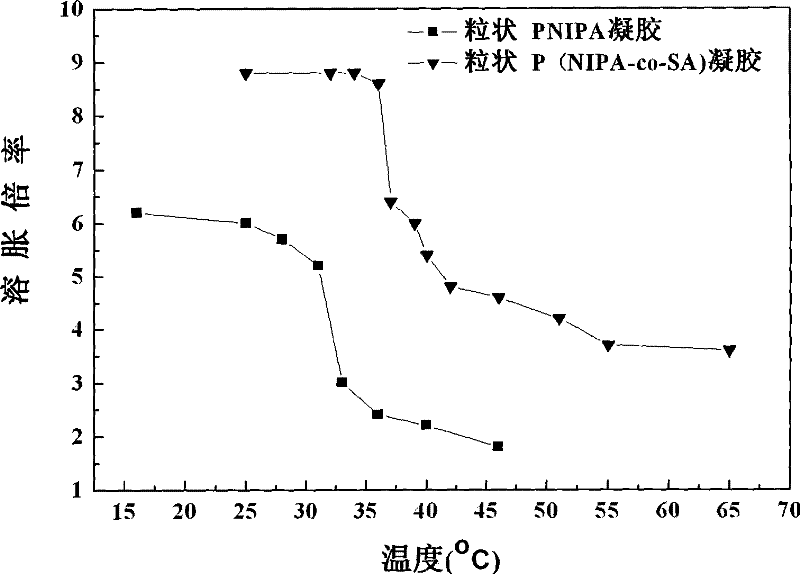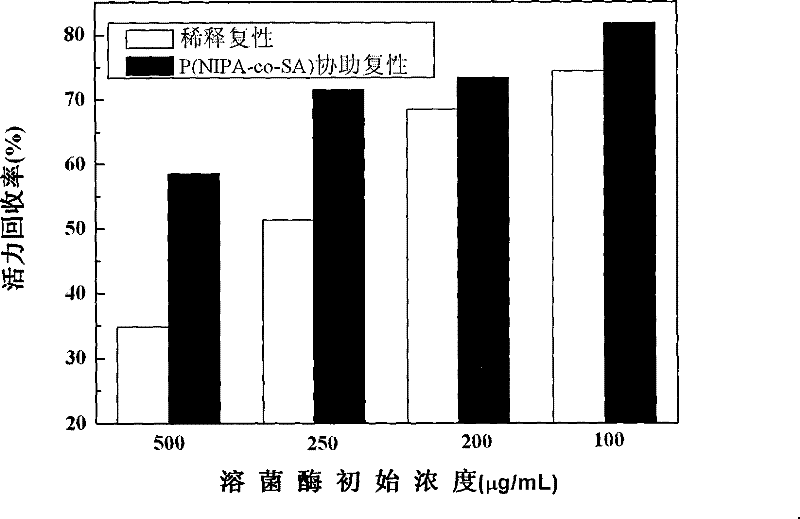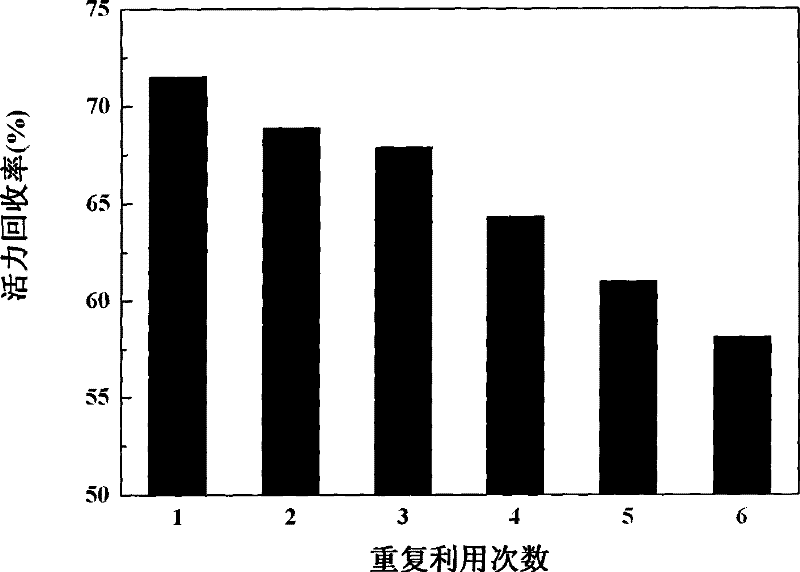Method for assisting lysozyme renaturation in vitro by granular poly(N-isopropylacrylicamide-sodium acrylate) copolymer hydrogel
A technology of isopropylacrylamide and sodium acrylate, applied in biochemical equipment and methods, enzymes, enzymes, etc., can solve the problems of narrow adjustable range of phase transition temperature, weak mechanical strength, and application limitations.
- Summary
- Abstract
- Description
- Claims
- Application Information
AI Technical Summary
Problems solved by technology
Method used
Image
Examples
Embodiment 1
[0020] 1) Take 40 mL of NaOH solution with a concentration of 0.2 mol / L, add excess acrylic acid aqueous solution, stir and react for 4 hours, evaporate under reduced pressure to remove the solvent and residual acrylic acid, and collect the sodium acrylate solid;
[0021] 2) Dissolve the surfactant Tween-80 in 75 mL of organic phase liquid paraffin to make the concentration 1% (g / mL), add it into the reactor, feed nitrogen gas, and stir for 20 minutes to fully disperse the surfactant. Then the raw material aqueous solution that the volume is organic phase volume 1 / 3 containing various reaction components is slowly added dropwise in the reactor with pipette gun, and raw material aqueous solution is composed of main monomer concentration 14% (g / g), cross-linking degree is 10% (g / g), the molar ratio of monomer N-isopropylacrylamide to comonomer sodium acrylate is 15.7:1, the concentration of oxidant ammonium persulfate is 0.5% (g / mL), under nitrogen protection After stirring for ...
Embodiment 2
[0024] 1) Take 50 mL of NaOH solution with a concentration of 0.2 mol / L, add excess acrylic acid aqueous solution, stir and react for 4 hours, evaporate under reduced pressure to remove the solvent and residual acrylic acid, and collect the sodium acrylate solid;
[0025] 2) Dissolve the surfactant Tween-80 in 75 mL of organic phase liquid paraffin to make the concentration 1% (g / mL), add it into the reactor, feed nitrogen gas, and stir for 30 min to fully disperse the surfactant. Then the raw material aqueous solution that the volume is organic phase volume 1 / 3 containing various reaction components is slowly added dropwise in the reactor with pipette gun, and raw material aqueous solution is composed of main monomer concentration 14% (g / g), cross-linking degree 10% (g / g), the molar ratio of monomer N-isopropylacrylamide to self-made co-monomer sodium acrylate is 19:1, the concentration of oxidant ammonium persulfate is 0.5% (g / mL), in nitrogen Under protection, after stirrin...
Embodiment 3
[0028] 1) Take 60 mL of NaOH solution with a concentration of 0.4 mol / L, add excess acrylic acid aqueous solution, stir and react for 6 hours, evaporate under reduced pressure to remove the solvent and residual acrylic acid, and collect sodium acrylate solid;
[0029]2) Dissolve the surfactant Tween-80 in 100 mL of organic phase liquid paraffin to make the concentration 1.5% (g / mL), add it into the reactor, blow in nitrogen, and stir for 30 min to fully disperse the surfactant. Then the raw material aqueous solution that the volume is organic phase volume 1 / 3 containing various reaction components is slowly added dropwise in the reactor with pipette gun, and raw material aqueous solution is composed of main monomer concentration 14% (g / g), cross-linking degree is 10% (g / g), the molar ratio of monomer N-isopropylacrylamide to self-made co-monomer sodium acrylate is 9:1, and the concentration of oxidant ammonium persulfate is 0.5% (g / mL). Under protection, after stirring for 40 ...
PUM
| Property | Measurement | Unit |
|---|---|---|
| particle size | aaaaa | aaaaa |
| lower critical solution temperature | aaaaa | aaaaa |
| particle size | aaaaa | aaaaa |
Abstract
Description
Claims
Application Information
 Login to View More
Login to View More - R&D
- Intellectual Property
- Life Sciences
- Materials
- Tech Scout
- Unparalleled Data Quality
- Higher Quality Content
- 60% Fewer Hallucinations
Browse by: Latest US Patents, China's latest patents, Technical Efficacy Thesaurus, Application Domain, Technology Topic, Popular Technical Reports.
© 2025 PatSnap. All rights reserved.Legal|Privacy policy|Modern Slavery Act Transparency Statement|Sitemap|About US| Contact US: help@patsnap.com



